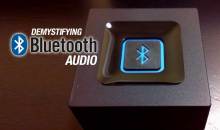Bluetooth, AirPlay and Play-Fi Audio Streaming
One of the latest trends in home theater is streaming audio to your home theater receiver from your iOS or Android device. You can do this via an app and a Wi-Fi connection (AirPlay or Play-Fi), or via Bluetooth. But it’s not that simple; there are a myriad of ways to get your audio from your phone or tablet to your speakers. I’ll try to go over the main ways this is accomplished here, but ultimately you need to understand your needs and the pros and cons of each method.
Wi-Fi Audio Streaming
There are multiple ways for you to use your wireless home network to stream audio. You can opt for one of several proprietary formats or you can simply connect your laptop or PC to a network and use DLNA services to pull audio from your library. When we talk about Wi-Fi streaming, however, we’re typically referring to the proprietary formats. There are many, but here are a few of the leaders:
Apple AirPlay
Apple AirPlay is a Wi-Fi streaming protocol that lets you easily redirect music from your iOS device to a compatible surround receiver or powered speaker. The thing about AirPlay that makes it attractive is that, as a wireless technology, AirPlay operates on top of your home’s existing wireless network. You just connect your device to your home network, and when you activate AirPlay your iOS device will let you send your music or video to any compatible device on the network. If you happen to have multiple Airplay devices in your home, you can stream to individually or all at once.
Play-Fi
Play-Fi, which is owned by DTS, is a new streaming media format that works on compatible devices and caters in particular to the Android-powered device market. Like AirPlay, and unlike proprietary systems like Sonos, Play-Fi connects devices over your existing WiFi network. The only present issue with Play-Fi is that, being a new technology, there are only a few devices currently supporting it. Play-Fi also hasn’t partnered with many streaming media providers as of yet, so Pandora and Spotify are the primary music providers for compatible applications. Conversely, AirPlay works within nearly all of the major streaming media provider apps, giving you near-limitless sources of music.
With current Play-Fi technology, file support is limited to 16-bit 44.1kHz (CD) quality for now, but hi-res audio support at up to 24-bit resolution is on the way.
Proprietary Mesh Networks
There are a number of proprietary mesh networks that ride atop your existing WiFi network to connect devices. One of the most popular is Sonos, which has a variety of speakers and powered or unpowered access points that can be networked within a home to play music. They even have a soundbar and the ability (with their latest update) to repurpose existing Sonos speakers for use as surround channels.
Proprietary mesh networks almost universally come with both limitations and cost. They are limited to a single manufacturer and so your product selection is likely to grow very slowly. Proprietary systems are also typically very expensive because they are designed to be an ecosystem into themselves, with special control software and unique features unavailable on other systems. The Denon HEOS speakers are similar to this type of system except that, unlike Sonos, they ride atop your existing WiFi network.
Bluetooth Audio Streaming
Bluetooth wireless technology is a standard designed for short distances (it uses the band from 2.40–2.48 GHz) up to 30 feet.
You might think Bluetooth audio streaming is a single “designation”. It’s not. There are a variety of versions and profiles, but we can help clear up the most common profile used for audio streaming. The latest Bluetooth version is almost always the best, requiring the least amount of setup, giving you more flexibility and offering the highest audio quality.
Advanced Audio Distribution Profile (A2DP)
You’ll see the A2DP designation a lot when you look at Bluetooth speakers and devices for streaming audio. A2DP simply refers to Bluetooth designed for one-way transfer of stereo audio. What really matters for user interaction, setup and features is the version. There have been seven, but the latest is V.4.
Bluetooth V.4 is also called “Bluetooth Smart” and has been out since 2010. It incorporates standard Bluetooth as well as the WiFi-based Bluetooth high speed and Bluetooth low energy protocols. There were two big problems with Bluetooth that kept it from truly being adopted as a leading wireless audio standard in the past. For one, it was originally designed as a replacement for Ethernet and USB cables tethering devices together on a desktop. That means that long range connectivity was not inherent in the design. With a limit of 30 feet, Bluetooth audio is naturally limited in how it can function in a whole-home scenario. Another related issue was connectivity. Bluetooth allows for a myriad of pairing methodologies, from passcode verification to near-automatic device pairing. It is still a crapshoot as to which system any particular device will use and how easy or difficult it will be to connect. In the past couple of years, most newer Bluetooth devices have utilized better and more convenient discovery methods.
Apt-X High Quality Bluetooth Audio
The second big problem with Bluetooth is sound quality. Bluetooth audio is far inferior in quality to lossless streaming over WiFi. To combat this, manufacturer-specific layers have been added to enable functionality not available by default in standard Bluetooth. Of these, Apt-X seems to be the best, offering near-lossless quality but still optimizing the stream to take into account bandwidth requirements of the format.
Apt-X has seemingly re-made Bluetooth into a viable streaming method, particularly for portable devices and connected PCs.
Bluetooth vs. “the other” Streaming Formats
So getting back to our original topic, the issue is which makes sense for streaming audio. If you’re looking at audio quality then lossless streaming of high-resolution media streams is the way to go. Apt-X Bluetooth fits in well here, but it requires a bit more proximity to your host AV system.
AirPlay also allows for 44.1kHz lossless stereo streaming and can be a great means of sending and receiving streaming media over your existing wireless network.
What you probably want to avoid, if quality is your goal, is standard Bluetooth streaming. The stock Bluetooth is very much a lossy medium and there is a huge difference between that and a lossless file. The difference is more than a little noticeable. Unfortunately, your other options are going to be a bit more proprietary, with AirPlay leading the way and Play-Fi just starting to get out of the dugout and looking hopeful. Of course, the proprietary streaming music systems are also an option, but they are typically pricey and offer a limited range of hardware that is compatible with the network audio streaming system.







thank you so much for clearing a lot of things up I have the Bluetooth apt X it sounds wonderful Arcam rblink
Is there any way to wirelessly “stream” the audio (or video) OUTPUT of a normal CD/DVD player (with good quality) – everything I see seems to talk only about receiving the stream and assumes that the stream is coming from somewhere like the Internet or a PC but not an existing music player?! Am i overlooking something very simple?
There are several solutions depending upon what you want to accomplish. Most are not going to be very economical for use with a CD or DVD Player, nor lossless. It may make more sense to convert those files to digital and then stream them using Bluetooth with AptX, Chromecast, or AppleTV from another device or computer. The wireless audio transmitter/receiver systems I’ve seen are made by companies like Lentenda, Signstek, and SainSonic and run from $50-$90. These are not lossless or HD transmitters. For HD, you start getting into wireless HDMI transmitters that start around $150 and up.
Root Android device and use Air Audio app to stream audio via wifi to Apple airplay
What would be the best way to stream high-quality audio to very large groups of people, using their handsets as receivers?
Probably time for an update to this article! Lots of new partners (hardware and streaming) for Play-Fi.